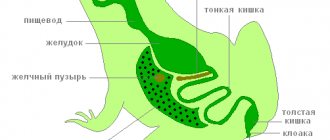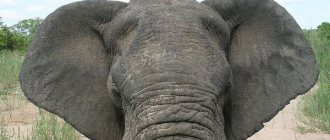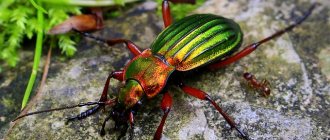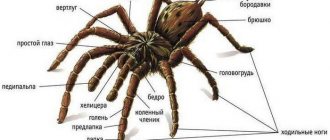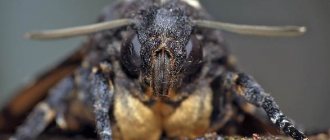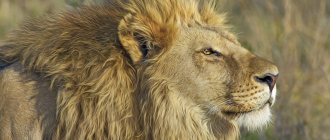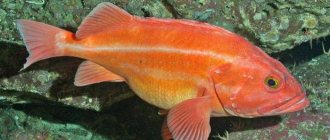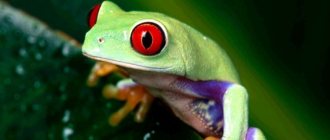The polar bear is one of the few animals that is classified into two types at once. So, in most countries this animal is classified as a marine mammal. Whereas in Canada it is considered exclusively as a terrestrial mammal. There is no clear opinion here.
So far, scientists have not clearly established what kind of roots this animal species has. According to numerous studies, it can be assumed that the ancestor of the polar bear is still the brown bear.
At the moment, there are about 19 subspecies of this animal, which are divided into 4 general groups.
Adult males are quite large - their weight reaches 350-600 kilograms. As for adult females, their weight is almost half that - more than 295 kilograms are practically never found.
In their class, polar bears are considered long-lived - in the wild, that is, in their natural environment, they live about 18-20 years. However, researchers have recorded several cases where the animal lived up to 30 years. Separately, it should be said about those individuals that live in artificial conditions - in this case, a bear can live up to 40 years. The record holder is Debbie Bear from Canada, who lived for 42 years, which is essentially twice as long as those who live in the wild.
Appearance
The scale of its size captivates the imagination. The weight of a polar bear reaches up to 1000 kg, height up to 3 meters.
The only thing stronger and more massive than this animal is the cannibal bear.
The giant's body is disproportionate to the head, on which there are small round ears and dark beady eyes. The limbs are short and powerful; the soles have hairs to prevent them from slipping on the surface.
The claws are sharp for snagging and cutting prey. The presence of membranes, like those of fish, are intended for effective swimming. The tail is barely noticeable behind the thick yellowish fur.
In young white individuals it is silvery. The structure is designed to ensure maximum heat retention. The fur is hollow inside, does not get wet in water, the skin is black to absorb sunlight, and a huge fat layer of 10 cm makes existence comfortable in severe winter conditions.
Writing a message about an animal
The information provided about the polar bear will be quite enough to compose an interesting message about the animal. It is important to remember that this form of report differs significantly from the usual abstracts, including only the most important information. This means that the message about the polar bear should be brief, accompanied by interesting pictures that display the main features of the animal, as well as clearly demonstrating the features of its existence.
The plan for a properly written report should include the following points:
- A short introduction, consisting of 2-3 small sentences, briefly characterizing the animal.
- A detailed description of the structural features of a polar bear (weight, height, presence of subcutaneous fat, as well as heat-saving and water-repellent wool, which helps adapt to the difficult conditions of the north).
- A short story about the animal’s diet, accompanied by interesting details about its hunting and taste preferences.
- Features of the mating season and reproduction with the obligatory indication of the habitat of pregnant females, the average number of offspring born, as well as facts about their rearing (long feeding, nomadic lifestyle, survival).
- At the very end of the message, the unique characteristics of the bear are given. Thus, the speaker can tell listeners about the developed visual and auditory functions of the animal, its quick reaction and other abilities.
The total volume of the message should not exceed 1200-1500 characters, being filled with the most interesting and informative information about the life of a polar bear.
The presentation of the report is also of great importance, and should include beautiful, high-quality photographs.
Lifestyle, nutrition
He tirelessly hunts seals (ringed seals) to satisfy his appetite; he eats up to 50 seals a year. Moreover, fat and skin are used as food; in severe hunger, everything else is used. In warm weather, a bear can feast on berries and other vegetation, and will not disdain carrion or bird eggs. Birds and Arctic foxes may be targeted. The person is not touched.
Thanks to their excellent swimming skills, fish are driven into gorges, and a seal is sat near a hole and stunned with a blow from a paw. A bear can sneak up unnoticed on its belly, hiding its eyes and nose. They are terrible cleanliness, after the meal there is a 15-minute wash and cleansing of the fur, for this they roll in the snow. Consummate hunters are blessed with a natural sense of smell, touch and superb vision, making him elusive and invincible.
Where does it live?
This majestic beast lives only in conditions that are comfortable for it - in the Arctic. There he reproduces, gets his food and builds snow dens in which he lives. Bears are found throughout the Arctic, but the largest numbers can be found in areas where there is a high population of ringed seals.
Here it would be appropriate to explain the ambiguous interpretation of attitudes towards class. The fact is that this type of polar bear has perfectly adapted to living both on land and on water. This is actually why some scientists classify it as a marine mammal, and others as a terrestrial mammal.
Animals, despite their strength and ability to adapt to different climatic conditions, are quite vulnerable in terms of survival. On the territory of Russia, these animals are included in the Red Book.
Reproduction
A female can bear offspring from the age of 4 years. She leaves a specific smell with her urine, and 4-5 males follow the trail. The bravest ones are selected; sometimes fertilization occurs from two different individuals at once.
There are one, two, or less often 3 cubs in a litter. Pregnancy lasts 250 days and just in time for spring, the babies leave the shelter with their mother. They feed on milk and do not leave the mother’s side until they are 2 years old. The mortality rate of bear cubs is too high, 30% of the total. In addition to hunger, they are exterminated by the polar animals themselves or they fall through the ice. A female can bring cubs once every 3 years.
Polar bear character
Oddly enough, the white polar bear is not afraid of people, but this does not mean that a person can make contact with him. Still, whatever one may say, this is a predator. An interesting fact: in Canada there is even a specialized “prison” where bears that come close to populated areas and pose a serious danger are taken. True, in appearance it looks more like a zoo and brawlers are kept there temporarily.
Bears are peaceful towards their relatives, but during the mating season they can fight. True, this requires a serious reason - if a rival has entered someone else’s territory and is laying claim to the female.
The white polar bear is also a traveler - it can easily cover both short and long distances. Moreover, this can be done by swimming, moving on ice floes or simply on land.
Popular message topics
- Ob River
Ob is a major river in Russia. Its length is 3,650 km, and its basin is almost 3 million km, which makes it the record holder in this area in the Russian Federation. The Ob is located in western Russia, most of it flows along the West Siberian Plain. - Sable
The sable is a small fur-bearing animal that belongs to the mustelidae family. He is beautiful and graceful. Its coat is smooth, medium length, and has different shades: almost black, brown, light brown, sandy and light yellow. - Choosing a profession
One of the main components of a happy life is work. What is important is that the work should be loved and bring pleasure. After all, when you wake up in the morning and realize that you are full of strength to achieve new career goals,
Structure
Polar bears are one of the largest land predators, second only to elephants and giraffes. The development of the species took place in the harsh conditions of the north, which led to changes in their structure, allowing them to withstand such a harsh climate. They have hollow fur that helps retain heat. The fur-covered feet have a special shape, similar to snowshoes, which allows them to avoid falling into the snow when walking and to cover about 30 km a day at speeds of up to 40 km/h. Like other waterfowl, they have membranes between their toes, thanks to which they swim and dive well.
External
These northern mammals can be simply enormous in size. Looking at them, you begin to involuntarily think about how much such a bear weighs.
It is known that they reach 3 meters in length, and some males can weigh up to 1 ton, although individuals weighing 400-500 kg are much more common, while females are much smaller in size - about 200-300 kg. The height at the withers is usually from 1-1.5 meters.
They have a strong build with a slightly pronounced shoulder hump. The head is small in size with a narrow muzzle and a flat profile, on the sides of which there are small rounded ears. The length of the neck is significantly longer than that of other species. The eyes are small, dark in color. The legs are long and well developed. The claws are slightly shorter than those of brown representatives - the length is on average about 7-10 cm, and the thickness is about 3 cm. The horny sheath of the claw itself is very strong and thick, and the claw phalanx on the front paws is located high. Their tail is very short - about 10 cm.
The structure of the skull of polar representatives differs from their brown relatives. In umoks it is located lower and has a greater length. In the area of the eye sockets there is a slight bend. Gender differences between the sexes are expressed in different lengths of the lower jaws and in the size of the molars, in addition to weight and overall body size.
Internal
An interesting feature is that the genetic structure of polar bears is such that they practically do not emit heat. Nature has provided them with several layers of complex protection, which allows them to almost completely isolate all their thermal energy inside the body.
The first line of defense is 10 cm of fat, which is not surprising considering what it eats. This layer is covered on top by a thick skin with an amazing genetic feature: their skin is black, which allows it to absorb more energy. On top of this is a layer of short, thick wool, which, like a good sweater, helps to retain and maintain warmth. And this system of perfect protection from the cold is completed by an ideal winter coat, consisting of 12 cm of thick fur that is absolutely waterproof.
Polar bears have amazing hearing and are able to determine the source of sound with an accuracy of 1 degree, which is much more reliable than modern instruments. In addition, they distinguish sounds in a range lower by 10 dB compared to humans.
The membrane of the mucous membrane in their nose is 100 times larger than that of a human and is equipped with 1 billion chemoreceptors, each of which is tuned to smell like an antenna. Such a sensitive sense of smell helps Ummkas smell prey at a distance of several kilometers, even when it is hiding under a meter-long layer of ice.
Lifestyle and hibernation
Polar bears can hibernate, but not for the whole winter and not every year. Basically, this is what mother bears do when they are waiting for cubs to appear. They make snow holes and live in them for several months until the babies are born and get a little stronger.
Animals of this species do not mate for a long time. But the cubs stay with their mothers for more than a year. At first they feed on milk, and then learn to survive in harsh climates and hunt.
